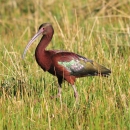Seasons of Wildlife
Baird Sparrow
The Baird’s sparrow is a true grassland specialist, requiring grasslands on both its breeding and wintering grounds. Baird’s sparrows arrive at Bowdoin Refuge around mid-May and begin nesting in late May. This sparrow breeds exclusively in the northern mixed-grass prairie from southeastern Alberta and southern Saskatchewan (Canada) through North Dakota and western Montana. Populations of many grassland birds including Baird’s sparrows have declined due to habitat loss from conversion to cropland, overgrazing, and poor rangeland management. Baird’s sparrows nest in idle to lightly grazed native prairie that has some residual litter cover and few shrubs.
Sprague’s Pipit
The prairie comes alive during the spring and summer months with the sights and "melodies" of our prairie inhabitants. One of those melodies is the territorial, flute-like song of the male Sprague’s Pipit. Difficult to spot but easy to hear, the male Sprague's pipit can be heard singing high above the open prairie landscapes of eastern Montana. Pipits arrive to our area in late April. They feed and nest exclusively on the ground therefore difficult to observe. The best time to observe pipits is during the spring and summer mating season, when males are intently performing their aerial displays and singing. Pipits nest in native prairie with high plant species diversity and few shrubs. Habitat loss has contributed to the dramatic decline of this species, and in 2010 it was listed as a candidate species under the Endangered Species Act.
Chesnut-Collared Longspur
Chesnut-collared longspurs breed only in short- mixed-grass prairie of the western and northern Great Plains and are the most abundant grassland songbird species that breeds at Bowdoin National Wildlife Refuge. Their breeding range extends from southern Alberta to southern Manitoba in Canada, south through eastern Montana and Wyoming, and east through North Dakota and South Dakota to western Minnesota. Longspurs nest in open prairie with minimal shrubs and litter. They prefer native grasslands that have been recently disturbed by fire, grazing, or mowing. Chesnut-collared longspurs arrive at Bowdoin National Wildlife Refuge in mid-April and begin nesting in early to mid-May.
Tundra Swan
Once known as the whistling swan in North America, tundra swans are attracted to large open wetlands for roosting and foraging. Its long neck allows it to feed in water up to 3.3 feet deep as it forages in shallow ponds, lakes, and riverine marshes. Tundra swans arrive on Bowdoin National Wildlife Refuge in the spring as early as mid-March and are gone by the end of the month. They leave their breeding grounds in Alaska early fall and appear again at Bowdoin Refuge late in September and stay through mid to late November.
White-faced Ibis
The white-faced ibis is a wader that probes deep in the mud with its long bill and feeds in shallow water or on the water surface. Ibises typically feed on crayfish, frogs, fishes, insects, newts, earthworms, and crustaceans in freshwater marshes. Most white-faced ibises arrive in Montana in May; however, they typically arrive on Bowdoin National Wildlife Refuge in late April. Ibises nest in areas where water surrounds emergent vegetation, bushes, shrubs, or low trees. White-face ibis do not require colony and roosting site isolation so nesting colonies are often share with black-crowned night-herons and Franklin’s gulls. Most begin their southern movement in August, and by September they are usually gone from the State.
Featured Species
The goal of the Bowdoin National Wildlife Refuge is to protect, enhance, and restore grassland habitat for breeding, and migratory birds and other wildlife while maintaining the biological diversity and integrity of native prairie grasslands, and to provide, protect, and manage wetland habitat for breeding and migratory birds and other wildlife that maintains the biological diversity and integrity of prairie pothole wetlands.
Historically, the northern Great Plains was a grassland-dominated system. This large expanse of treeless prairie has been fragmented by cropland, shelterbelts, human settlement, and the uncontrolled spread of nonnative Russian olive trees. Native mixed-grass prairie will be protected, restored, and enhanced to provide quality nesting habitat for targeted grassland-dependent birds.
Enhanced or managed wetlands are managed to mimic natural conditions for target wetland-dependent migratory birds during migrations and breeding seasons.
There are 119 species of birds that have been documented breeding and nesting on the refuge complex. About 29 species use upland habitats, particularly native grassland, for nesting. The known most abundant breeding and nesting passerines using native grasslands were chesnut-collared longspur, Savannah sparrow, grasshopper sparrow, Baird’s sparrow, Sprague’s pipit, and western meadowlark.
The importance of this area to breeding and migrating waterfowl and shorebirds has long been recognized, serving as a catalyst for establishment of Bowdoin National Wildlife Refuge. Many mammals use wetlands and surrounding vegetation for water and cover but muskrats, mink, raccoon, and beaver are the most commonly associated with the lakes and wetlands in the refuge. Concentrations of thousands of migrating shorebirds are found throughout most the refuge, particularly in drier years when low water levels leave large areas of exposed shoreline. As part of the central flyway, wetlands in the refuge are used by many waterfowl species as important stopover sites on migration routes.
Piping plovers are listed as threatened under the Endangered Species Act. Approximately 3,325 acres of Bowdoin National Wildlife Refuge have been designated as critical habitat for the Great Plains population. The last known plover nest on the refuge occurred in 1999. Habitat degradation of beach conditions, lack of water, and encroachment of Russian olive trees were all causes to loss of nesting birds. The trees have since been removed and the beach was re-sloped with new substrate. Water is still the limiting factor for creating attractive nesting habitat. In years when water is available, Piping Plover Pond is filled before May in hopes of attracting plovers once again to nest on the refuge.
